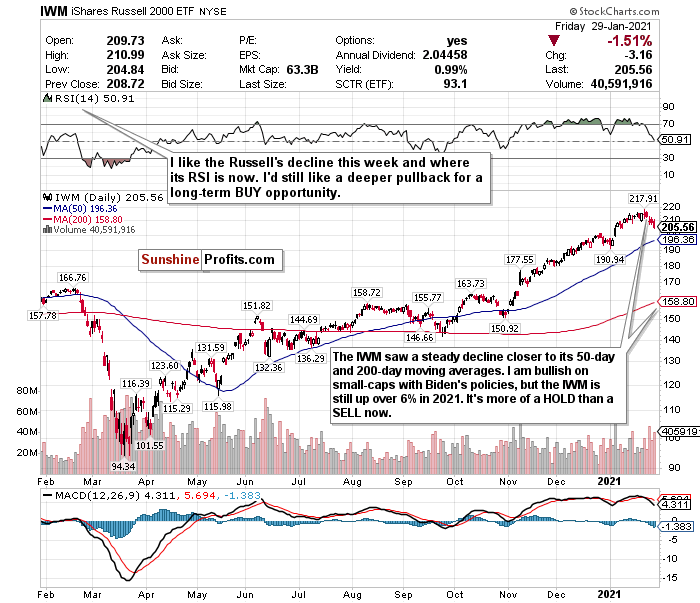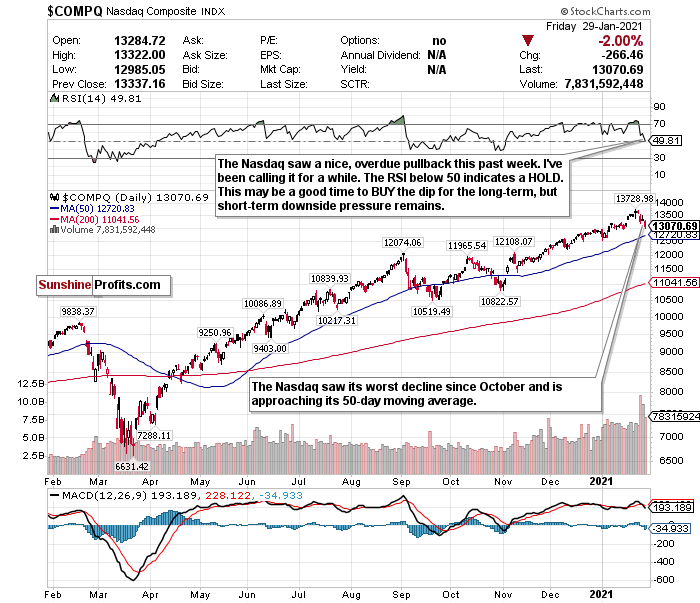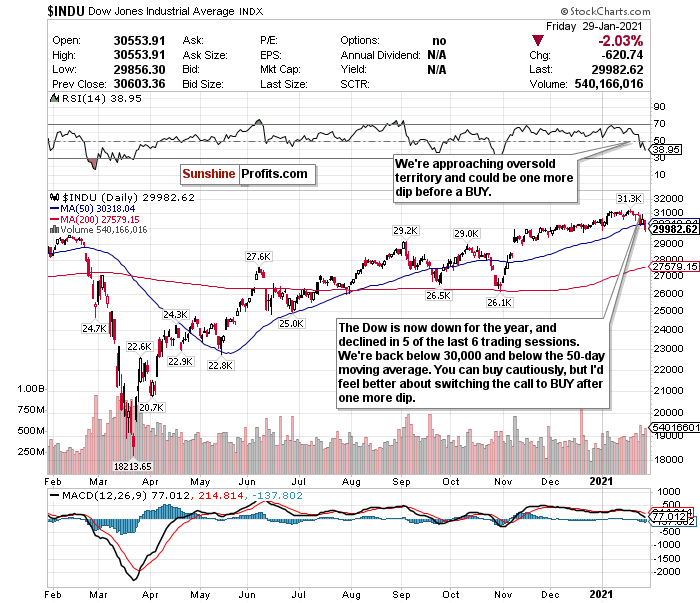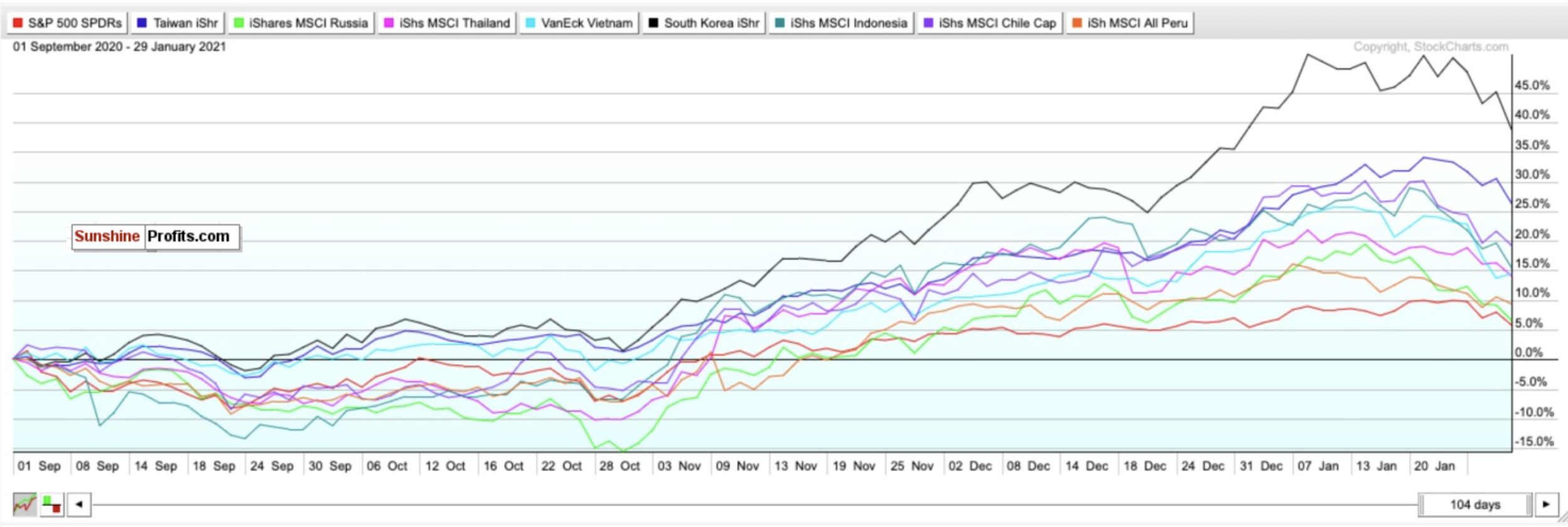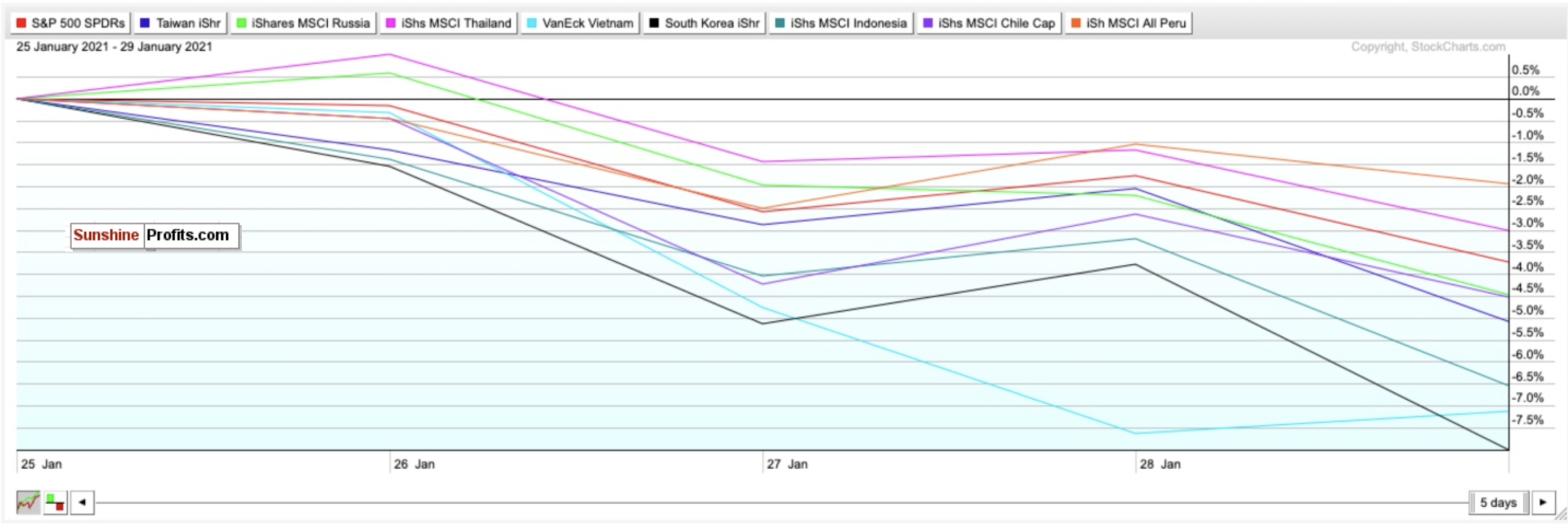After what happened last week with beaten-down stocks such as GameStop (GME) and AMC (AMC), there are indeed signs of a bubble forming. While these stocks don’t necessarily reflect the broader market, I have been calling a downturn for weeks.
Complacency is by far the most significant risk in the markets right now, along with overstretched valuations beyond the GameStop “stonks,” and the possible return of inflation if the Fed lets the GDP run hot like I think they will.
According to a recent Bank of America survey of 194 money managers, bullishness on stocks is at a three-year high, and the average share of cash in portfolios, which is usually a sign of protection from market turmoil, is at the lowest level since May 2013.
Complacency.
I still think we are long overdue for a correction since we haven't seen one since last March. The manic moves of the past week excite me but greatly concern me.
Corrections are healthy for markets and more common than most realize. Only twice in the last 38 years have we had years WITHOUT a correction (1995 and 2017).
Thus far, what has occurred in January could be the potential start of the correction I have been forecasting. A correction could also be an excellent buying opportunity for what should be a great second half of the year.
We could also finally be approaching BUY levels on many of the SELL and HOLD calls I’ve made the last few weeks.
Outside of my BUY call on the iShares MSCI Taiwan ETF (EWT), which has gained 10.12% since I made the call on 12-3, I called the Nasdaq and the Russell both overbought and foresaw last week’s downturn.
I made the SELL call on the QQQ Nasdaq ETF 1-25, and since then, it has declined 4.13%. I made the SELL call on the Russell 2000 IWM ETF 12-16 anticipating this eventual pullback. The Russell is now at its lowest level since the beginning of the year declined 4.30% in the last week.
I also called the Invesco Optimum Yield Diversified Commodity Strategy No K-1 ETF (PDBC) a BUY on 12-3, and it has gained 8.33%.
Meanwhile, I’ve called the Dow Jones a HOLD for the last two months, and since 12-3, it is practically flat and up 0.15%.
I’m not highlighting these calls to brag or toot my own horn. I’m highlighting these calls to remind everyone to please be level headed during these manic times and to please understand that stocks don’t only go up. The market saw its worst week since October last week, and has now declined in two of the last three weeks. More could come in the short-term.
While GameStop and AMC are exciting, understand the risks you’re taking and don’t follow the herd.
On the other hand, do not run and hide from a market decline, and do not let this deter you from chasing your goals. The market has overheated, but it is still not quite a broad sector-specific bubble like it was back in 2000. Yes, there are sectors more overvalued than others. But as we saw last week it’s more stock-specific. People still forget that shares of Eastman Kodak skyrocketed by 1,481% in three days last July. The broader indices seem to have done just fine since then.
My goal for these updates is to educate you, give you ideas, and help you manage money like I did when I was pressing the buy and sell buttons for $600+ million in assets. I left that career to pursue one where I could help people who needed help, instead of the ultra-high net worth.
With that said, Therefore, to sum it up:
While there is long-term optimism, there are short-term concerns. A short-term correction between now and the end of Q1 2021 is possible. I don't think that a decline above ~20%, leading to a bear market will happen.
Hopefully, you find my insights enlightening. I welcome your thoughts and questions, and wish you the best of luck.
We’re all in this together!
A Nice Pullback for Small-Caps
Figure 1- iShares Russell 2000 ETF (IWM)
Since November, the Russell 2000 small-cap index has been on quite the run and is up nearly 6% for 2021.
But as tracked by the iShares Russell 2000 ETF (IWM), small-cap stocks underperformed the larger indices this past week. I foresaw this decline coming for over a month now.
As a result of the IWM’s sharp pullback, its RSI is back down at a more manageable level in the low 50s.
The index is no longer technically overbought and at its lowest level in weeks. While I still think that it has more room to fall because it overheated so much the last several months, it is no longer at a SELL level for me.
I love small-cap stocks for the long-term, especially as the world reopens and the Biden agenda eventually passes an aggressive stimulus package.
I’d like to see another sharp decline, though, before calling this a BUY. It could happen this month.
HOLD, but if there is a deeper pullback, this is BUY for the long-term recovery.
Is It Safe to Buy Tech Again?
Figure 2- Nasdaq Composite Index $COMP
Earnings season for tech stocks hit record numbers this week. But once again, when investors get what they expect, it’s usually more of a reason to sell rather than buy.
Tech valuations, especially the tech IPO market, terrify me. SPACs don’t help either. However, the Nasdaq last week declined to a more "normal" level.
While short-term, downside pressure still remains, the index may be another decline or two away from being a long-term BUY bet.
Last week's decline was needed, but there are still echoes of the dot-com bubble 20-years ago. My fears have been slightly eased, in any case. I like that the Nasdaq is approaching its 50-day moving average with an RSI below 50.
I am bullish on earnings even if investors have largely ignored them, and am especially bullish on specific tech sectors such as cloud computing, e-commerce, and fintech for 2021.
Continue to monitor the RSI of this index. The RSI is how I have called the Nasdaq since December. While an overbought or oversold RSI does not automatically mean a trend reversal, it has with the Nasdaq.
The Nasdaq pulled back on December 9 after exceeding an RSI of 70 and briefly pulled back again after passing 70 again around Christmas time. We also exceeded a 70 RSI just before the new year, and what happened on the first trading day of 2021? A decline of 1.47%.
The last time I changed my Nasdaq call from a HOLD to a SELL on January 11 after the RSI exceeded 70, the Nasdaq declined again by 1.45%.
When the Nasdaq hit an RSI of over 73 prior to January 25th, I switched my call back to SELL, and the QQQ declined 4.13%.
The Nasdaq is trading in a precise pattern.
I still love tech and am bullish for 2021. We're approaching a BUY level, but for now, I'm going to stay conservative and switch it to a HOLD.
For an ETF that attempts to directly correlate with the performance of the NASDAQ, the Invesco QQQ ETF (QQQ) is a good option.
The Dow Could Be Approaching BUY Territory
Figure 3- Dow Jones Industrial Average $INDU
The Dow has been the least impressive index in 2021 and has been the laggard thus far. Even during inauguration week, when the Nasdaq and the S&P continued reaching record highs, the Dow quietly declined.
Year-to-date, the Dow is down roughly 0.80% and has seen a decline of nearly 2.70% in the last two weeks.
The Dow’s downturn is not necessarily a bad thing. Out of all the indices, the Dow is closest to a BUY, and is the only index that hasn’t traded like a maniac.
Look, declining in 6 of 7 days is never fun. But it’s bound to happen when complacency is the norm.
Its sub-40 RSI is attractive as a potential BUY because there is so much long-term upside. If you want to start initiating positions, be my guest. It’s at a good point, especially considering that many analysts are calling for it to end the year at 35,000.
I still have short-term questions and concerns about the Dow Jones, but it is almost at a certain BUY level.
COVID-19’s curve in the U.S. may be improving somewhat, and while I am encouraged by potential improvements in the vaccine rollout, I am still concerned about short-term economic and political headwinds.
My call on the Dow stays a HOLD, but this could change soon.
For an ETF that looks to directly correlate with the Dow's performance, the SPDR Dow Jones ETF (DIA) is a strong option.
Mid-Term/Long-Term
Taiwan, South Korea, and More for Best Emerging Market Exposure
Figure 4- SPY, EWT, ERUS, THD, VNM, EWY, EIDO, ECH, EPU comparison chart- Sep. 1, 2020-Present
It was a down week for emerging markets, as it was for the broader markets. All the more reason to strengthen my BUY calls on the following emerging markets due to a declining dollar, a surge in demand for commodities and minerals, and shifting demographics. Developed markets are old. Emerging markets are young. Period.
Many predicted a COVID baby boom to happen, but we might be in a baby bust. Initial stats show significant drops in December 2020 births, compared to a year earlier.
PWC also believes that emerging markets (E7) could grow around twice as fast as advanced economies (G7) on average in the coming decades.
For 2021, the following are my BUYs for emerging markets and why:
iShares MSCI Taiwan ETF (EWT)- Developing country, with stable fundamentals, diverse and modern hi-tech economy, regional upside without China’s same geopolitical risks.
iShares MSCI Thailand ETF (THD)- Bloomberg’s top emerging market pick for 2021 thanks to abundant reserves and a high potential for portfolio inflows. Undervalued compared to other ETFs.
iShares MSCI Russia Capped ETF (ERUS)- Bloomberg’s second choice for the top emerging market in 2021 thanks to robust external accounts, a robust fiscal profile, and an undervalued currency. Red-hot commodity market (a big deal for a declining dollar), growing hi-tech and software market, increasing personal incomes.
VanEck Vectors Vietnam ETF Vietnam (VNM)-Turned itself into an economy with a stable credit rating, strong exports, and modest public debt relative to growth rates. PWC believes Vietnam could also be the fastest-growing economy globally. It could be a Top 20 economy by 2050.
iShares MSCI South Korea ETF (EWY)- South Korea has a booming economy, robust exports, and stable yet high growth potential. The ETF has been the top-performing emerging market ETF since March 23.
iShares MSCI Indonesia ETF (EIDO)- Largest economy in Southeast Asia with young demographics. The fourth most populous country in the world. It could be less risky than other emerging markets while simultaneously growing fast. It could also be a Top 5 economy by 2050.
iShares MSCI Chile ETF (ECH)- One of South America’s largest and most prosperous economies. An abundance of natural resources and minerals. World’s largest exporter of copper. Could boom thanks to electric vehicles and batteries because of lithium demand. It is the world’s largest lithium exporter and could have 25% of the world’s reserves.
iShares MSCI Peru ETF (EPU)- A smaller developing economy but has robust gold and copper reserves and rich mineral resources.
These emerging market ETFs have all had a down week, bringing many of them to negative levels for 2021. However, Taiwan is still up nearly 3% year-to-date.
Thus far, Indonesia has been the laggard in 2021 and has declined roughly 5.79%.
Last week South Korea was the worst-performing emerging market, which is to be expected when you’ve surged by 127.81% since March 23.
Vietnam also declined by nearly 7.15% last week as well, primarily due to reimposed lockdown restrictions.
Don’t let this deter you, however. South Korea’s decline was overdue, and VNM is as good a BUY opportunity as there is for emerging markets. A recent CNBC report showed that Vietnam was likely the top-performing Asian economy in 2020- including China.
Vietnam shockingly did not see a single quarter of economic contraction, and government estimates showed that the Vietnamese economy grew 2.9% last year from a year ago, topping China’s forecast-beating 2.3% growth during the same period.
Outside of the aforementioned country-specific ETFs, you can also BUY the iShares MSCI Emerging Index Fund (EEM) for broad exposure to Emerging Markets.
Pay Very Close Attention to Inflation
Pay very close attention to the possible return of inflation by mid-Q2 or Q3. An aggressive stimulus could be imminent, and the Fed has not been shy in its plans to allow the GDP to heat up. It may overshoot in the medium-term as a result. GDP growth could stutter in Q1 2021 but pay close attention to what happens in Q2 and Q3 once vaccines begin to roll out on a massive scale. Inflation will inevitably return with the Fed’s policy and projected economic recovery by mid-2021.
The 10-year yield’s recent rally, as well as the 10-year breakeven rate, reflects this as well.
If you are looking to the future to hedge against inflation, look into TIPS, commodities, gold, and potentially some REITs.
In the mid-term, I have BUY calls on the SPDR TIPS ETF (SPIP), the Invesco Optimum Yield Diversified Commodity Strategy No K-1 ETF (PDBC), the SPDR Gold Shares ETF (GLD), and the iShares Cohen & Steers REIT ETF (ICF).
Long-Term
There are some things to worry about in the short-term. But I’m convinced that economic stimulus and the progress made with administering the vaccines bodes well for stocks in the second half of 2021. We may be at the beginning of the end of the pandemic-but over the next 1-3 months, this could be a very bumpy ride back.
There does seem to be one consensus though: 2021 could be a big year for stocks.
Small-caps, value stocks, and cyclicals, could especially surge. I just have a much better feeling for them in the second half of the year. I think we could be another down week or two before entering a very strong buying opportunity for the second half of the year.
Summary
The current headwinds are very concerning. But I remain optimistic for the second half of 2021 despite the bumpy road there. Until COVID-19 is eradicated, a battle between optimism and pessimism is inevitable.
Despite the strong earnings we are seeing so far, a short-term correction is likely. But do not let this scare you.
Corrections are NORMAL. What happened last March is ABNORMAL.
The crash and subsequent record-setting recovery we saw in 2020 is a generational occurrence. I can’t see it happening again in 2021. If there is a short-term downturn, take a breath, stay cool, and use it as a time to find buying opportunities. Do not get caught up in fear and most of all:
NEVER TRADE WITH EMOTIONS.
Consider this. Since markets bottomed on March 23rd, ETFs tracking the indices have seen returns like this: Russell 2000 (IWM) up 108.70%. Nasdaq (QQQ) up 85.46%. S&P 500 (SPY) up 68.10%. Dow Jones (DIA) up 63.27%.
In the long-term, markets always end up moving higher and are focused on the future rather than the present.
To sum up all our calls, we are nearing BUY territory but I have a HOLD calls for:
- The iShares Russell 2000 ETF (IWM)
- the Invesco QQQ ETF (QQQ)
- the SPDR S&P ETF (SPY), and
- the SPDR Dow Jones ETF (DIA)
For all these ETFs, I am more bullish in the long-term for the second half of 2021 but I like this past week’s pullback.
For the mid-term and long-term, I recommend selling or hedging the US Dollar, and gaining exposure into emerging markets.
I have BUY calls on:
- The iShares MSCI Emerging Index Fund (EEM),
- the iShares MSCI Taiwan ETF (EWT),
- the iShares MSCI Thailand ETF (THD),
- the iShares MSCI Russia ETF (ERUS),
- the VanEck Vectors Vietnam ETF Vietnam (VNM),
- the iShares MSCI South Korea ETF (EWY),
- the iShares MSCI Indonesia ETF (EIDO),
- the iShares MSCI Chile ETF (ECH),
- and the iShares MSCI Peru ETF (EPU)
Additionally, because I foresee inflation returning as early as mid to late 2021…
I also have BUY calls on:
- The SPDR TIPS ETF (SPIP),
- the Invesco Optimum Yield Diversified Commodity Strategy No K-1 ETF (PDBC)
- the SPDR Gold Shares ETF (GLD), and
- the iShares Cohen & Steers REIT ETF (ICF)
Thank you.
Matthew Levy, CFA
Stock Trading Strategist


